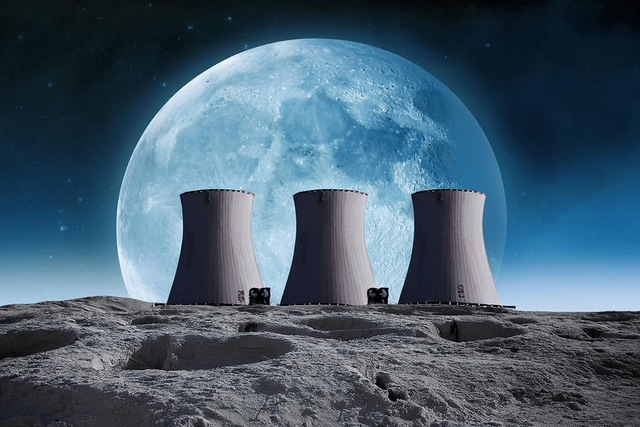
Source
As my older readers will recall, during the second half of the last century, in the midst of the Cold War, Russia and the United States were engaged in a fierce battle to win the space race. Several decades later, it seems to have begun again, but this time Russia is not only not alone, but has now joined its muscular cousin, China. This isn't going to be easy for the United States if it wants to keep up.
Como recordaréis los más añosos de mis lectores, durante la segunda mitad del siglo pasado y en plena guerra fría, Rusia y EEUU mantenían una dura disputa por ganar la carrera espacial. Varias décadas después parece que ha vuelto a empezar, pero esta vez Rusia no solo no está sola sino que ahora se ha unido a su primo el cachas, es decir, China. Esto no se lo va a poner nada fácil a los Estados Unidos si quiere estar a la altura.
China and Russia have announced plans to build a nuclear power plant on the surface of the Moon as part of their joint project, the International Lunar Research Station (ILRS). The goal of this partnership is to install a nuclear reactor between 2033 and 2035, significantly ahead of Western programs and ensuring a stable and long-lasting energy source to power a future permanent lunar base.
China y Rusia han anunciado planes para construir una central nuclear en la superficie de la Luna como parte de su proyecto conjunto, la Estación Internacional de Investigación Lunar (ILRS, por sus siglas en inglés). El objetivo de esta unión es instalar un reactor nuclear entre los años 2033 y 2035, adelantándose sensiblemente a los programas occidentales y asegurando una fuente de energía estable y duradera para alimentar una futura base lunar permanente.

Source
Given its remoteness, among other factors, nuclear power is seen as the only viable option for providing continuous electricity on the Moon, where the lunar day lasts 27 Earth days and there is no sunlight for half of that time. This makes solar panels insufficient to keep the equipment and systems of a lunar base operational during the long lunar nights. The nuclear reactor will supply electricity to the ILRS, facilitating experiments, human habitation, and autonomous operations for extended periods.
Dada su lejanía entre otras cosas, la energía nuclear es vista como la única opción viable para suministrar electricidad de forma continua en la Luna, donde el día lunar dura 27 días terrestres y la mitad de ese tiempo no hay luz solar. Esto hace que los paneles solares no sean suficientes para mantener operativos los equipos y sistemas de una base en la Luna durante las largas noches lunares. El reactor nuclear permitirá abastecer de electricidad a la ILRS, facilitando experimentos, vida humana y operaciones autónomas durante largos periodos.
This plan has been officially presented by Chinese officials at several international conferences, with representatives from 17 countries and organizations interested in the ILRS participating. The installation and assembly of the nuclear reactor is expected to be carried out by robots, to avoid exposing humans to radiation and other associated risks. China's Chang'e-8 mission, scheduled for 2028, will test construction technologies and energy systems that will lay the groundwork for the future nuclear power plant and lunar base.
Este plan ha sido presentado oficialmente por los responsables chinos en varias conferencias internacionales, con la participación de representantes de 17 países y organizaciones interesadas en el ILRS. Se prevé que la instalación y el montaje del reactor nuclear se realicen mediante robots, para evitar exponer a los humanos a la radiación y otros riesgos asociado. La misión china Chang’e-8, programada para 2028, probará tecnologías de construcción y sistemas energéticos que sentarán las bases para la futura central nuclear y la base luna.

Source
For its part, Russia will contribute its expertise in space nuclear energy, considered a world leader in launching reactors into space, according to Chinese officials. This ambitious project responds to the global competition for lunar exploration, especially in the face of NASA's Artemis program, which seeks to return American astronauts to the Moon by 2025. China and Russia seek to position themselves as leaders in the new lunar race, inviting other countries to join their initiative.
Por su parte Rusia aportará su experiencia en energía nuclear espacial, considerada líder mundial en el envío de reactores al espacio, según funcionarios chinos. Este ambicioso proyecto responde a la competencia global por la exploración lunar, especialmente frente al programa Artemis de la NASA, que busca llevar astronautas estadounidenses de regreso a la Luna en 2025. China y Rusia buscan posicionarse como líderes en la nueva carrera lunar, invitando a otros países a sumarse a su iniciativa.
There's no doubt this will greatly accelerate the colonization of the Moon. With this competition, the US will have to get its act together with its Artemis project if it doesn't want to end up looking ridiculous. Personally, I think this US tactic of excluding China from all international projects is costing it dearly, as the Chinese aren't intimidated and are hitting back hard.
No cabe duda de que esto acelerará en gran medida la colonización de la Luna, con esta competencia EEUU tendrá que ponerse las pilas con su proyecto Artemis si no quiere acabar haciendo el ridículo. Personalmente creo que esta táctica de USA de excluir a China de todos los proyectos internacionales le está saliendo bastante cara, ya que los chinos no se dejan intimidar y están pegando muy duro.
More information/Más información
https://www.reuters.com/business/energy/china-led-lunar-base-include-nuclear-power-plant-moons-surface-space-official-2025-04-23/